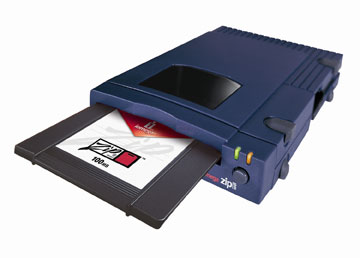
For those of you that have run out of hard drive space (or will soon do so), consider purchasing an Iomega Zip Drive. Lightweight, compact and easy to install, the Zip Drive is the “average user’s” answer to “what to do about storage space.”
Installation of the Zip Drive is simple and straightforward, with all necessary cables and software provided. Connect the end of the SCSI cable marked “ZIP” to your Zip Drive and the other end to the SCSI connection on your Mac. Connect the external power supply (supplied) to the Zip Drive, and just make sure that the green power light comes on. Start up your Mac with the extensions off, insert the 100 MB “tools” disk into your Zip Drive, insert the “install” floppy for the Macintosh into your floppy drive and double click on the Zip install icon. Follow the simple instructions and presto, your Zip Drive is ready for you to use.
The Zip Drive comes with one (1) 100 MB disk which contains all the necessary software tools that you’ll need to use your Zip Drive. One of the programs is GUEST, which is a portable driver that allows you to easily move the Zip Drive from your computer to another one. With the GUEST program, you don’t need to permanently install the driver or the ZIP TOOLS software. ZIP TOOLS software is set up so that when you install the Zip software on your Mac, the ZIP TOOLS becomes a Macintosh disk. If you were to do the install on a PC, it would become a DOS/WINDOWS tools disk. You can then use the disk to install the ZIP TOOLS software on the same type of system. The tools software also has a read/write protect feature that permits you, using software, to write protect a disk, write protect a disk and assign a password to remove the write protect, and read protect your disk so that it can’t be read/written to, unless the user has your specific password.
Being a SCSI device, (also available as a parallel system for PC users) the Zip Drive is very easy to install and prepare as part of the SCSI chain. As part of the SCSI chain, each device that you add must have a different ID number, with your Mac having a standard ID number of “0”. The Zip Drive is factory preset to ID number “5”, but you can change it to “6” by moving a SCSI ID switch on the back of the unit up. The Zip Drive also comes with a SCSI termination switch, which allows you two options. If the Zip Drive is going to be the last or the only item in the SCSI chain, the switch goes into the ON position. If you put the Zip Drive in the middle of the chain, you must place the switch in the OFF position to turn off termination.
Using the Zip Drive is as easy as 1-2-3. Place the 100 MB Zip disk into the Zip Drive (be aware that the disk that comes with the unit contains about 35 MB’s of software, plus game demo’s and other stuff) and you’re set. Additional 100 MB disks from Iomega (available in 1,3 or10 packs) and now ATTOM disks (available in 1,5 or10 packs) and Sony disks (available in 1,5,10 or 25! packs), all competitively priced – $18-20 for singles, reduced rates for packs. Want a new folder on the Zip disk? Just go to the menu, drop down to new folder, click and go. Do what you need to do and when you’re ready to stop working, just click and drag the ZIP icon to the trash and the Drive ejects the disk for you. No complex series of actions or waiting for the disk to eject. Zip, it’s there!
All a bed of roses? Well, the Zip drive is not exactly the world’s fastest removable storage medium. With a 29 ms access time and 1.25 MB per second transfer rate, the Zip is easily beat by the EZ 135 Syquest Drive (13.5 ms access time and 2.4 MB per second transfer rate and 35 megs more storage space) BUT, if you’re an average normal user, looking for additional storage space at a reasonable price, the Zip, with its ease of use and no problem setup, is the way to go.
-Russ Walkowich

Leave a Reply
You must be logged in to post a comment.